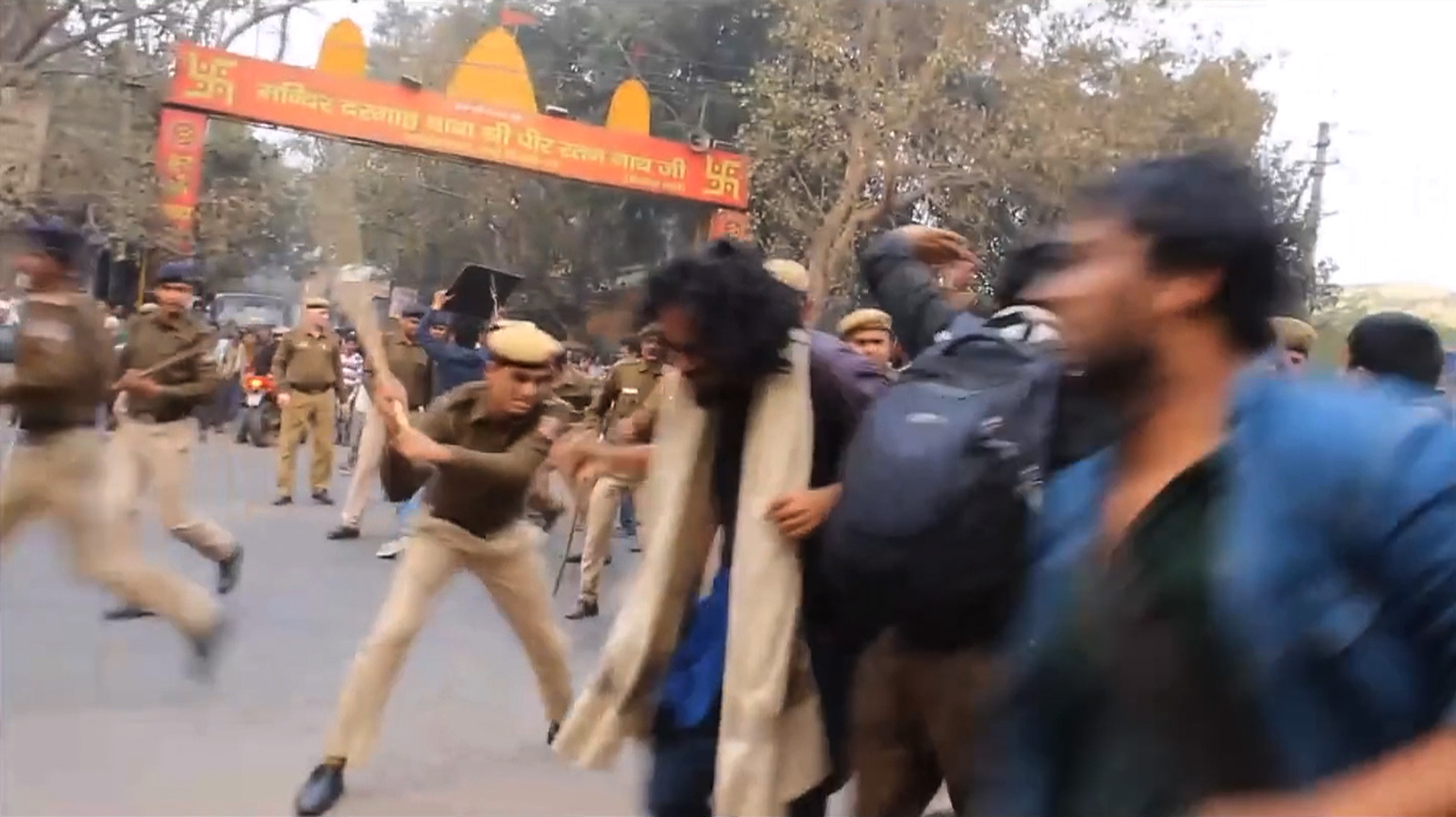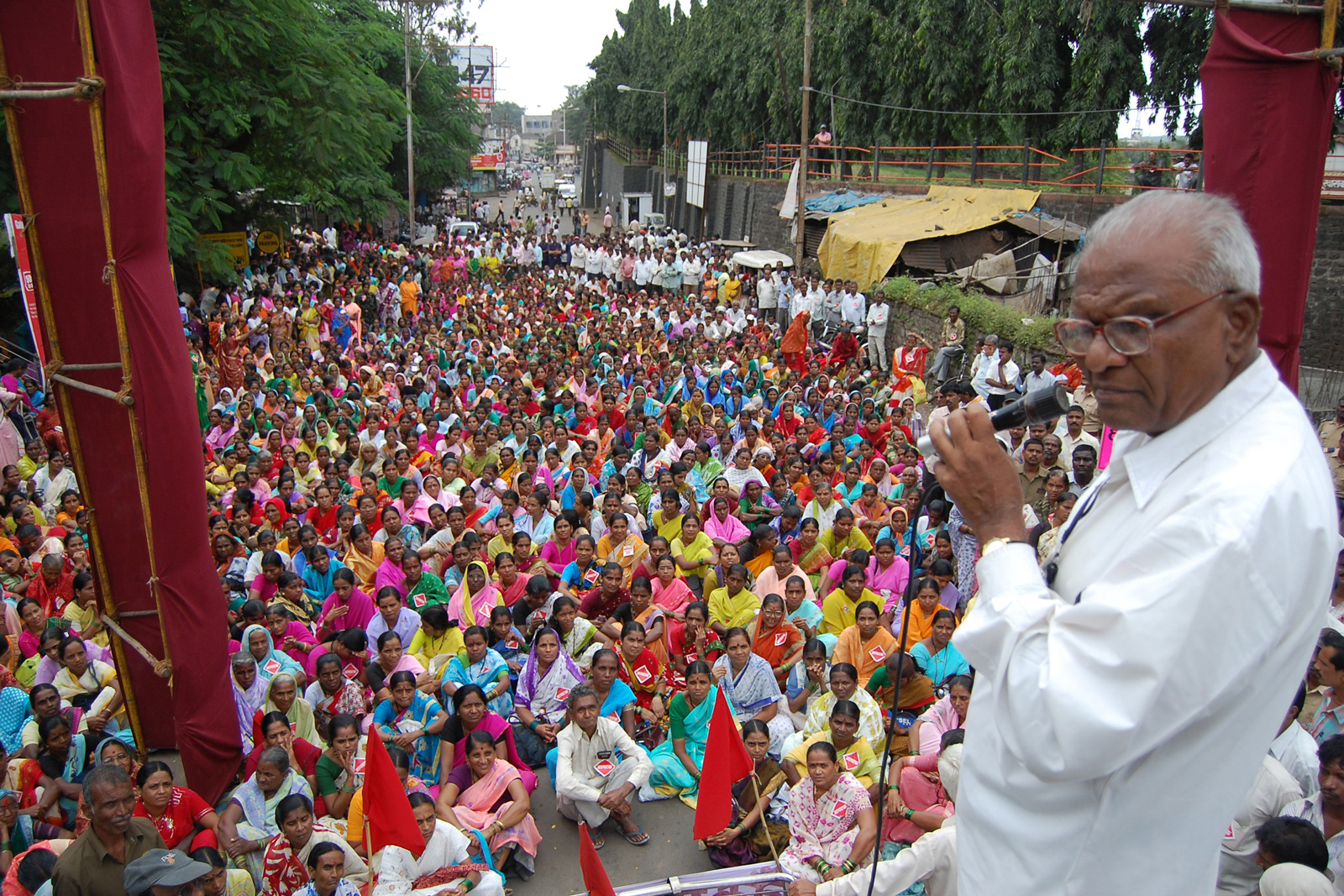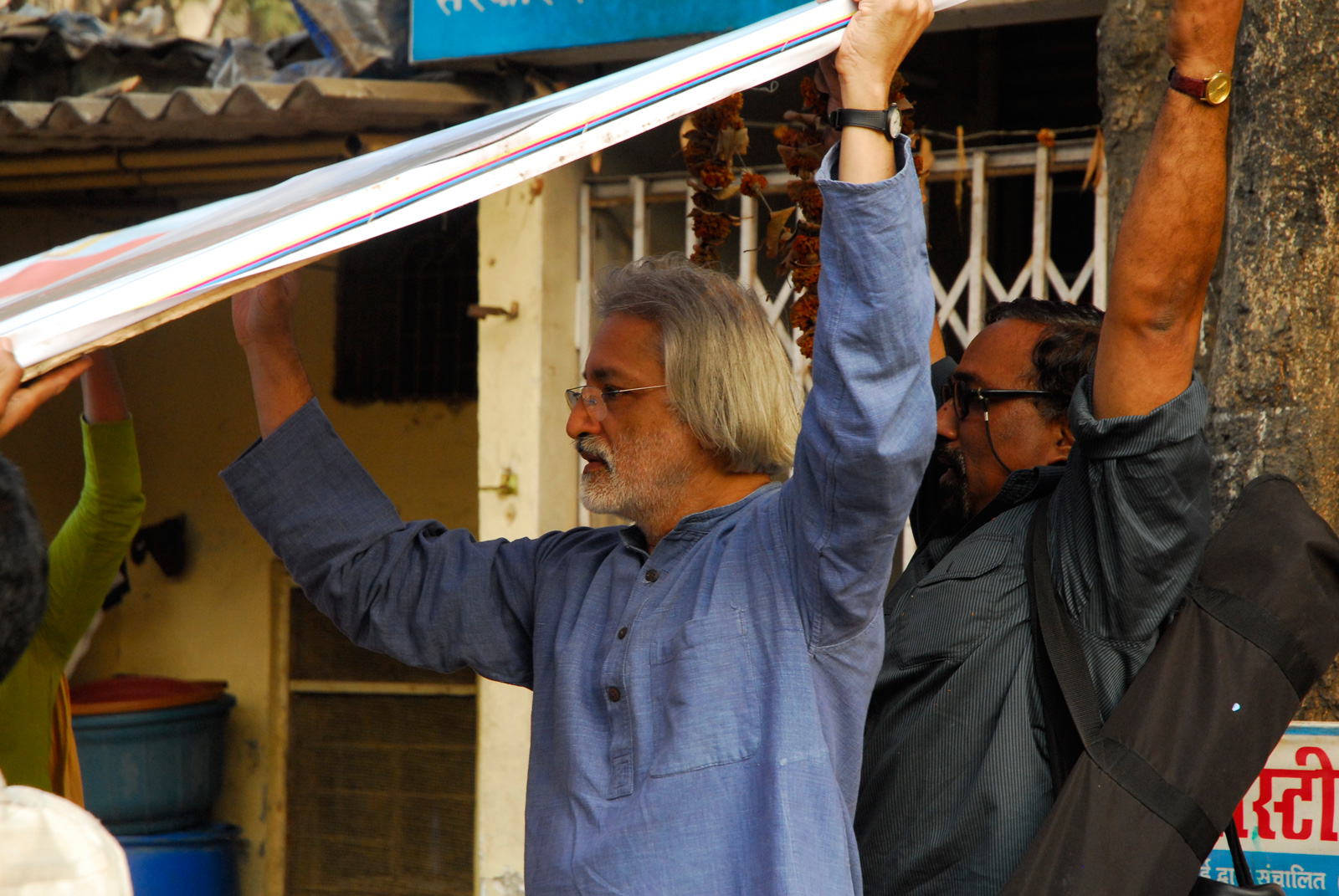The first murder came as a shock; the second suggested there might be a larger plot; by the third there was talk of government collusion; and when the fourth happened one felt it would not be the last. The victims—Narendra Dabholkar, Govind Pansare, M.M. Kalburgi, and Gauri Lankesh—were all killed in the same way, shot point-blank with a 7.65mm pistol by a gunman who came and fled on a two-wheeler. All beloved activists and thinkers, who wrote in the vernacular press, they had been vocal opponents of the BJP and its brand of Hindu nationalism. Their assassinations were meant to send a message, and far-right trolls on social media duly rejoiced. “One bitch died a dog’s death,” a man from Gujarat wrote on Twitter, referring to Lankesh; his account was followed by Prime Minister Narendra Modi.
These killings, which happened between 2013 and 2017, lie at the heart of Vivek (Reason), a four-hour documentary by Anand Patwardhan. (The version I viewed was re-edited and posted to YouTube ahead of India’s general election earlier this year.) Each chapter opens with an allusion to the crimes—a motorcyclist is seen driving down a dark road—and some third of the show is given over to telling the victims’ life stories. Yet the murders are only the starting point. Behind the grisly events, Patwardhan sees the broader threat of religious intolerance that is once again spreading across India. It is this trend that he sets out to chart.
Shot across the country between 2013 and 2018, Vivek is a work of great ambition, really a report on Modi’s first term in power. It covers most of the big and small abominations now committed almost daily in India in the name of Hinduism: from cow vigilantism and the lynchings of Dalits, to the rewriting of history and attacks on higher education. But Patwardhan also spends time in the pockets of secular resistance that have emerged, profiling many activists (including the four murdered), journalists, students, and politicians. These are the two poles of the series, the villains and heroes. Their struggles and clashes are the highlights of an unfolding battle between faith and reason whose outcome Patwardhan believes will shape the future of Indian democracy.
*
The series roughly divides into three parts. In the first Patwardhan travels to southern Maharashtra, where he speaks to the families and comrades of Dabholkar, Pansare, and, to a lesser extent, Kalburgi. Mixing interviews with the victims’ families and comrades, and clips of their own speeches, Patwardhan assembles a memorial to these three men. They are presented as classic figures in the tradition of the Enlightenment, promoting rational thinking to fight Hindu superstition, and the hierarchy of caste (Pansare even conducted inter-caste marriages, which remain a kind of social taboo). Their stories are contrasted with portraits of various local Hindu religious and cultural groups, most with ties to politics, who preach blind adherence to twisted versions of scripture and a militant hatred of Islam. In one disquieting sequence, Patwardhan speaks to journalists about the Goa-based Sanatan Sanstha, a shadowy Hindu “spirituality organization,” which apparently runs retreats and offers faith healing services but was found to be storing arms and explosives at their headquarters in 2018. They are widely believed to have links to the thugs who killed Dabholkar and Lankesh. (Under interrogation, the accused have admitted to being inspired by a book brought out by the Sanstha.)
In the second section Patwardhan visits two places that have become infamous for religious violence. He speaks to the family of Mohammad Akhlaq, a Muslim man who was lynched by his Hindu neighbors in the village of Dadri, Uttar Pradesh, for the alleged crime of consuming beef (this crime sparked huge protests). Later, with the Dalit parliamentarian Jignesh Mevani, he travels around Gujarat on an inspiring civil disobedience march sparked by a gruesome incident in the town of Una, where seven Dalit men were beaten in public for skinning a cow carcass.
The final section is set at two premier Indian universities. Here the Hindu right’s fear of rational thinking is given its purest expression. At the Jawaharlal Nehru University in Delhi, the BJP’s student wing harasses progressive students and teachers who question the basis of Hinduism and its caste order; at Hyderabad Central University, they launch a smear campaign of such ferocity against the Dalit students’ association that a brilliant scholar, Rohith Vemula, is driven to suicide in what has been labelled an “institutional murder.”
On the whole Vivek leaves little doubt that political Hinduism is a dangerous threat to Indian democracy. In scene after scene, we witness how dogma is manipulated by cynical godmen and politicians, and how in turn the forcefield of faith pushes us to indulge our worst instincts. This menace isn’t new—in fact, it has been building for decades. To understand the rise of modern Hindutva, we have to look at Patwardhan’s older films.
Advertisement
*
Anand Patwardhan was born in Mumbai in 1950. He grew up in a family of Gandhian Socialists—several relatives on his father’s side were freedom fighters imprisoned by the British—and absorbed progressive ideas at home. After completing a degree in sociology at Brandeis University in 1972, and briefly volunteering in Cesar Chavez’s United Farm Workers union, he returned to India in 1974 to teach in Madhya Pradesh (Chavez appears in Patwardhan’s 1981 film A Time to Rise, about migrant farm laborers in British Columbia). Later that year he joined an anti-corruption struggle led by the Gandhian Jayprakash Narayan in Bihar, where he “accidentally” fell into filmmaking. Asked to make some record of the movement, he ended up shooting enough footage for a full-length documentary, which would become his debut, Waves of Revolution (1975).
“This documentary is made of speeches, interviews and songs” an early title card reads in Waves. To a good extent this has remained the template of all Patwardhan’s films. A kind of hybrid activist-flâneur, he embeds himself in social movements, catching history as it’s made by the people, rally by rally, meeting by meeting.
Waves itself is a chronicle of the Bihar agitation. Patwardhan follows as Narayan’s student followers spread his message among semi-literate peasants, sitting in on their ad-hoc lessons in village schools and spelling out their ideology through his voiceover. He also speaks to the locals directly; there is a long and somber sequence about the persistence of caste. And already here Patwardhan’s weakness for music is evident. The film is punctuated by shots of the Gandhians marching between villages, singing a version of “We Shall Overcome” in Hindi. It is in such sequences of music and drama, versions of which recur in all of Patwardhan’s documentaries, that the director’s own idealism is most poignantly expressed.
Waves ends with news of Indira Gandhi’s Emergency. It remains Patwardhan’s only truly buoyant film. Since then, as the Indian state has continually grown more authoritarian, and as the term “democracy” has steadily been drained of meaning, he has turned his focus from revolution to resistance. Focusing on the plight of some of the country’s most dispossessed communities—political prisoners, slum-dwellers, Adivasis (indigenous people), Dalits—he has in some four decades amassed a body of work that stands as a shattering indictment of the country’s ruling classes (a group from which he does not exclude itself). One measure of his success is that all of his films have initially been censored or banned outright, by both the Congress Party and the BJP. The actual business of filmmaking is, in fact, only part of his practice; the rest of his time is spent contesting censorship and putting on free screenings in villages and poor urban neighborhoods across the country.
From the early 1990s, Patwardhan has been at work on an ambitious series about the rise of religious fundamentalism. Though he has looked at radical Sikhism and Islam, his main focus has been the Hindutva movement.In Ram Ke Nam (1991), the director followed L.K. Advani on his infamous “Rath Yatra,” when the BJP president traveled around India in a Toyota remodeled to resemble a chariot, drumming up support for construction of a Ram temple at the site of the Babri mosque. (The Babri Masjid is a mosque built in the sixteenth century in Ayodhya, a town in what is now Uttar Pradesh. In a narrative poem written in Sanskrit a century later, Tulsidas popularized the idea that this town is the birthplace of Lord Ram—who, until then, was not really a major Hindu god.) Patwardhan used the opportunity to observe the electrifying effect Advani had on young men in small towns across the Hindu-dominated north. The film powerfully captures the emergence of a new politics of resentment. At rally after rally, we hear from saffron-clad lumpen youth with little prior feeling for religion drawn like moths to a flame by the lure of a strong “Hindu” identity.
Father, Son, and Holy War (1995), which unfolds against the backdrop of terrible communal riots in Mumbai, is a study of the rhetoric of emasculation—virile Islamic invaders conquering effeminate Hindu men—is cunningly exploited by India’s farright parties (this film focuses on the Shiv Sena, a chauvinist Maharashtran party that appeals to Hindu Maratha pride). War and Peace (2002) is a sober account of the bizarre theological fantasies woven through the BJP’s fiscally ruinous decision in 1999 to develop nuclear weapons. These two films show an evolution in Patwardhan’s style, which grows increasingly loose and freewheeling. Again and again, there are jump cuts and long panning sequences—from an aphrodisiac vendor to a fulminating politician; from murals of war-like Hindu gods to Swayamsevaks brandishing swords—that go beyond common sense to touch on the more elusive aspects of Hindutva’s appeal.
Advertisement
*
Patwardhan does not plan his documentaries—he compares his technique to “stream-of-consciousness” writing—and instead simply follows his instincts. In the course of making a film he usually amasses hundreds of hours of footage, ranging from focused interviews to records of performances to more casual studies of public space. What is remarkable is that at the editing table he is able to weave this rough, heterogenous material into fine-grained chronicles that are tense and gripping.
His procedure resembles Frederick Wiseman’s and also that of Patricio Guzman, whose great, ruminative documentary trilogy The Battle of Chile, on Salvador Allende’s rise and fall, made a strong impression on Patwardhan when he was a student. All three of these directors proceed without assumptions and, with utmost open-ness, rely entirely on their instincts and conscience—as if seeing through the everyday to the history concealed behind.
Vivek, however, is more rigidly structured. Though Patwardhan shot the series without a script, the narrative feels more premeditated and less inquisitive. This is perhaps because the director relies too heavily on his Manichean idea that India is facing another episode in the “ancient battle between reason and belief.” This stark contrast certainly gives Vivek a grandeur and moral clarity. But by focusing so acutely on religion and reason, Patwardhan ends up overlooking the many other factors that are also crucial to Hindutva’s rise. (Here he comes close to resembling those Western critics who blame all of the Middle East’s problems on “Islam”).
Perhaps the most glaring of these oversights has to do with economics. Ever since the Indian markets were liberalized in the early 1990s—right around the time of the Ram Janmabhoomi movement—inequality has been steadily growing in the country and it is today at dizzying heights. These decades also saw the handover of public resources to corporations, the erosion of public welfare, a right-wing takeover of mass media, and much else. Not once are these developments alluded to in Vivek. Likewise, there is little mention of the enormous failures of the Congress, and other opposition parties. In this strange way, Patwardhan actually de-politicizes Hindutva.
The obsession with reason also has another drawback, which has been noted by the critic Kamayani Sharma in her recent review of the series in Artforum. While acknowledging Vivek’s moral seriousness, Sharma wonders whether the director’s sober, logical style of cinema has any traction in our “post-truth” world. If people on the right are really so lost in belief, can any reasoned argument, based on historical evidence and hard facts, win them over? If not, is Patwardhan simply preaching to the already converted?
Many viewers have been frustrated by Patwardhan’s mulish commitment to old-fashioned reason. Yet it would be unfair to reduce Vivek to its guiding idea. Despite its sometimes simplistic and didactic perspective, the series on the whole retains a rich texture and is brimful with vivid scenes and details—middle-class people chanting Modi’s name at a temple; a young man who has the letter “Om” shaved at the back of his head—that convey just how deep the roots of Hindutva have spread. By looking unflinchingly at the country’s public life, Patwardhan has given us yet another disquieting portrait of India. Even if it does not raise all the right questions, Vivek is a powerful account of the problems confronting the world’s largest democracy today.
The eight-chapter, four-hour film version of Vivek was released in 2018. The re-edited sixteen-part, three-hour version can be viewed on YouTube. This article has been updated to clarify this distinction.





